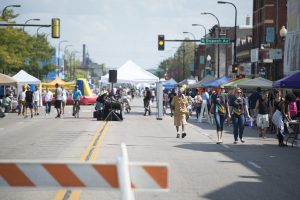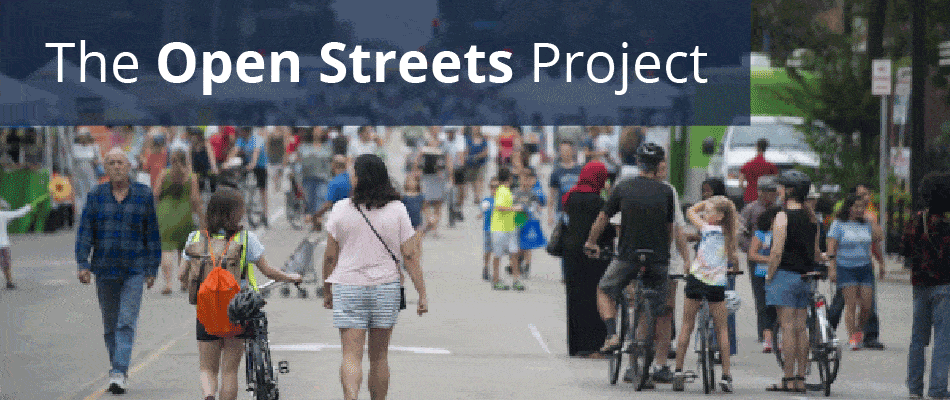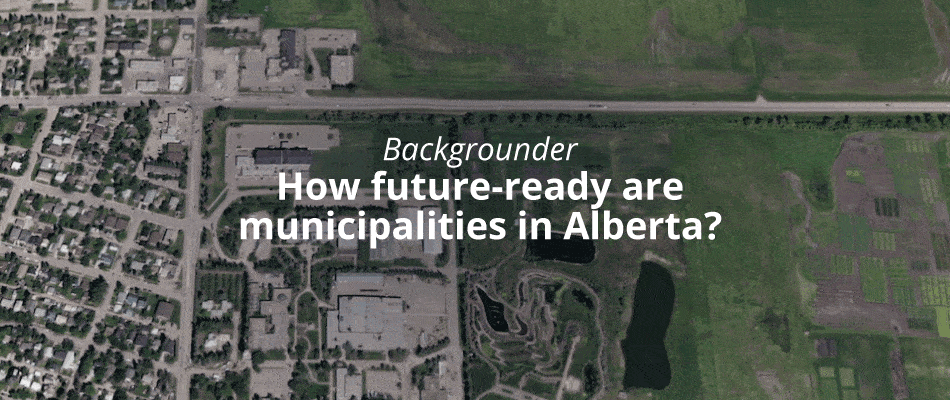Temporarily closing streets to vehicles can create open spaces for the community
Open streets programs create opportunities to experience a community in a different way. By closing streets to vehicle traffic for a short period of time, open streets programs aim to improve social integration, recreation and civic participation.
The Open Streets Project is a collaboration between two non-governmental organizations, 8 80 Cities and Street Plans, that facilitates the creation of open streets in cities throughout North America.
A review on the trends of open streets identified that most open streets are around 3 km in length, with the vast majority of routes on iconic main streets. In the United States, most programs occur only once a year while 3% of open streets occur weekly.
Read more about the Open Streets Project.
Benefits of open streets
 The goal of open streets is to create a space for accessible exploration of a community. By enabling individuals to explore on foot (or human-powered mobility such as a bike or skateboard), neighbourhoods can foster a sense of community and create occasions to enjoy a street instead of simply passing through.
The goal of open streets is to create a space for accessible exploration of a community. By enabling individuals to explore on foot (or human-powered mobility such as a bike or skateboard), neighbourhoods can foster a sense of community and create occasions to enjoy a street instead of simply passing through.
The benefits of open streets include:
- Free recreation, which can improve public health
- Encouraging alternative transportation and public transit
- Promoting civic engagement
- Supporting local businesses and highlighting local events
- Reducing street noise
Closures can planned to be held on a regular basis, such as once a month on a Sunday. Although similar events can be hosted in parks or on streets that are open to vehicles, open streets showcase accessibility in a typically less accessible location.
If individuals walk to a store during an open streets event, they are more likely to walk the next time they visit the street (even if it is open to vehicle traffic).
How to start an open streets program
 The Open Streets Project includes an open streets toolkit for all stages of an event:
The Open Streets Project includes an open streets toolkit for all stages of an event:
- Building a team and developing your vision
- Planning your route and timing
- Funding your program
- Marketing your event
- Preparing for the logistics
- Evaluating the success of the program
The toolkit outlines the common approach for starting an open street program, but the results look incredibly different throughout North America. From bike days to annual events, open streets programs are neighbourhood initiatives that reflect the interests and goals of local communities.
More information is available in the Open Streets Project toolkit.
Role of municipalities to open streets
The toolkit is intended for use by community groups, municipalities or other local organizations. No matter who initiates a project, a partnership between community groups and the local government is necessary.
Municipalities contribute support by enabling road closures with actions that may include providing barricades/signs, traffic management and re-routing of public transit. Some local government contribute funding, whether that is direct monetary support or covering the cost of secondary services such as policing, marketing and handling permits.
Collaboration between the organizers and municipalities contributes to successful and sustainable open streets projects.
Getting the benefits without closing streets
Some of the benefits of open streets can be accomplished without the challenge of repurposing streets. By applying a complete streets concept, municipalities can promote alternative transportation, civic engagement and recreation on a regular basis. Complete streets has similar goals as open streets, but uses deliberate design to promote the benefits year round while allowing vehicles on the road.
Edmonton
The goals of complete streets in Edmonton are to create spaces that are safe, comfortable and welcoming for all ages and abilities. This is accomplished by designing main streets that accommodate driver, pedestrians, transit users, cyclists and more. Deliberate design considers the needs of all ages and abilities – today and tomorrow.
Edmonton has completed pilot projects in new residential areas and on main streets, and plans on applying complete street concepts to future projects.
Learn more about Edmonton’s complete streets initiative.
Calgary
As a similar program to Edmonton’s, the complete street initiative in Calgary focuses on creating neighbourhoods that are more livable. Improving the safety and accessibility of streetscapes is intended to promote local businesses by creating attractive and welcoming spaces.
Complete streets will be integrated into the development of new and reconstructed streets in communities throughout Calgary.




Recent Comments